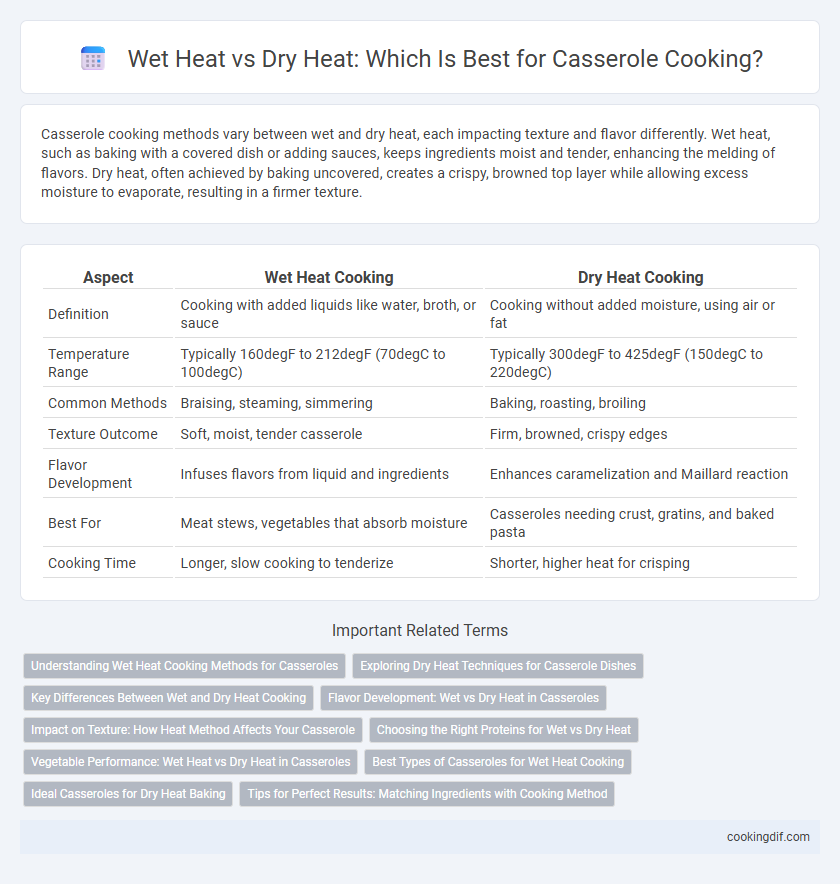Casserole cooking methods vary between wet and dry heat, each impacting texture and flavor differently. Wet heat, such as baking with a covered dish or adding sauces, keeps ingredients moist and tender, enhancing the melding of flavors. Dry heat, often achieved by baking uncovered, creates a crispy, browned top layer while allowing excess moisture to evaporate, resulting in a firmer texture.
Table of Comparison
| Aspect | Wet Heat Cooking | Dry Heat Cooking |
|---|---|---|
| Definition | Cooking with added liquids like water, broth, or sauce | Cooking without added moisture, using air or fat |
| Temperature Range | Typically 160degF to 212degF (70degC to 100degC) | Typically 300degF to 425degF (150degC to 220degC) |
| Common Methods | Braising, steaming, simmering | Baking, roasting, broiling |
| Texture Outcome | Soft, moist, tender casserole | Firm, browned, crispy edges |
| Flavor Development | Infuses flavors from liquid and ingredients | Enhances caramelization and Maillard reaction |
| Best For | Meat stews, vegetables that absorb moisture | Casseroles needing crust, gratins, and baked pasta |
| Cooking Time | Longer, slow cooking to tenderize | Shorter, higher heat for crisping |
Understanding Wet Heat Cooking Methods for Casseroles
Wet heat cooking methods for casseroles involve simmering or braising ingredients in liquids such as broth, wine, or sauce, which helps tenderize tougher cuts of meat and infuses deep flavors throughout the dish. This technique allows moisture to penetrate ingredients, resulting in a rich, cohesive texture that balances softness with structure. Using wet heat enhances the melding of flavors and maintains moisture, preventing the casserole from drying out during long baking times.
Exploring Dry Heat Techniques for Casserole Dishes
Dry heat cooking techniques for casseroles, such as baking and roasting, enhance flavor development through Maillard reactions and caramelization on the dish's surface. These methods create a crispy, golden-brown crust while preserving the moisture of the ingredients inside. Using dry heat at moderate temperatures ensures even cooking and intensifies the casserole's overall texture and taste.
Key Differences Between Wet and Dry Heat Cooking
Wet heat cooking methods for casseroles involve moisture such as simmering or steaming, which helps tenderize ingredients by breaking down collagen and connective tissues, resulting in a moist and flavorful dish. Dry heat techniques, like baking or roasting, use indirect heat to create a browned crust and concentrated flavors while potentially drying out the casserole if overcooked. Understanding these key differences allows chefs to control texture and moisture levels, optimizing the final casserole quality.
Flavor Development: Wet vs Dry Heat in Casseroles
Wet heat in casseroles, such as baking with sauces or broths, promotes tenderizing tougher cuts of meat and infusing ingredients with rich, moist flavors. Dry heat methods, like baking without excessive liquid, encourage Maillard reactions that enhance surface browning and complex, caramelized flavors. Combining both wet and dry heat techniques in casserole cooking balances tenderness and depth of flavor, resulting in a more satisfying dish.
Impact on Texture: How Heat Method Affects Your Casserole
Wet heat, such as baking a casserole covered with liquid or sauce, helps retain moisture and results in a tender, soft texture by slowly breaking down proteins and starches. Dry heat methods, like uncovered baking or broiling, promote browning and crispiness on the surface, creating a firmer, more textured top layer while potentially drying out the interior. Choosing between wet and dry heat directly impacts the casserole's final mouthfeel, balancing tenderness and crustiness to suit different recipes and preferences.
Choosing the Right Proteins for Wet vs Dry Heat
Selecting the appropriate protein for casserole cooking depends on the heat method; wet heat techniques like braising or stewing suit tougher cuts such as beef chuck, pork shoulder, or chicken thighs that benefit from slow cooking to become tender. Dry heat casseroles, including baked or roasted dishes, work best with leaner proteins like chicken breasts or fish fillets that cook quickly without drying out. Matching protein type to the cooking method ensures optimal texture and flavor by leveraging moisture retention and heat distribution.
Vegetable Performance: Wet Heat vs Dry Heat in Casseroles
Vegetables in casseroles respond differently to wet and dry heat methods, with wet heat promoting tenderness and moisture retention while preserving nutrients such as vitamin C and antioxidants. Dry heat tends to enhance caramelization and deepen flavors through Maillard reactions but can lead to moisture loss and firmer textures. Optimal vegetable performance often involves combining both wet and dry heat to balance softness, flavor development, and nutrient preservation in casserole dishes.
Best Types of Casseroles for Wet Heat Cooking
Casseroles cooked with wet heat methods, such as braising or baking with added liquids, are ideal for dishes featuring tougher cuts of meat, dense vegetables, and grains that benefit from slow, moist cooking to tenderize and develop deep flavors. Examples of the best types of casseroles for wet heat cooking include beef stew casseroles, chicken and rice casseroles, and vegetable gratins with cream or broth bases. Using wet heat helps maintain moisture, enhances texture, and infuses ingredients with rich, savory aromas during the extended cooking process.
Ideal Casseroles for Dry Heat Baking
Ideal casseroles for dry heat baking typically include layered pasta dishes, vegetable gratins, and souffles, which rely on a crisp, browned top and even cooking. Dry heat allows Maillard reactions to develop complex flavors and textures, enhancing dishes like lasagnas or potato au gratin. Avoid highly liquid dishes in dry heat baking, as moisture-rich casseroles require wet heat methods to prevent drying out.
Tips for Perfect Results: Matching Ingredients with Cooking Method
Choosing between wet and dry heat cooking methods for casseroles depends on ingredient moisture content and texture goals. Wet heat methods, like braising or baking covered, enhance tenderness for ingredients such as tougher meats and dense vegetables by retaining moisture. Dry heat methods work best for ingredients that benefit from caramelization and crispness, like cheese toppings and quick-cooking vegetables, ensuring a balanced casserole texture.
Wet vs dry heat for casserole cooking Infographic

 cookingdif.com
cookingdif.com